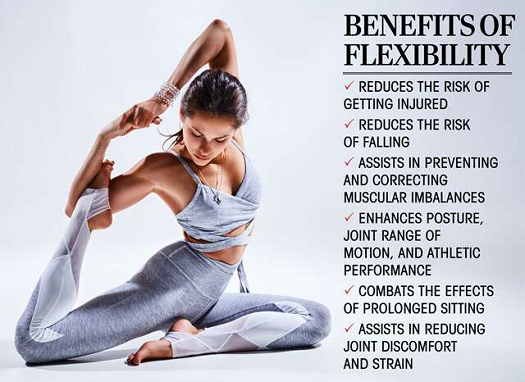Unit 3: Flexibility
Unit 3: Flexibility

Unit 3: Flexibility

Unit 3: Flexibility
This unit describes flexibility and its relationship to functional health. Students will learn the benefits of a flexible body.
Flexibility
Flexibility is the ability of a joint or series of joints to move through an unrestricted, pain free range of motion. Although flexibility varies widely from person to person, minimum ranges are necessary for maintaining joint and total body health. Many variables affect the loss of normal joint flexibility including injury, inactivity or a lack of stretching. The range of motion will be influenced by the mobility of the soft tissues that surround the joint. These soft tissues include: muscles, ligaments, tendons, joint capsules, and skin. A lack of stretching, especially when combined with activity can lead to a fatigue induced soft tissue shortening over time.
Effects of being inflexible
Inadequate flexibility will have a negative effect on the body in 3 significant ways:
Joints require movement through a full range of motion to maintain the health of cartilage and other structures within the joint with increased blood supply and nutrients to joint structures with increased quantity of synovial joint fluid (oil in the crank case). This effect can be particularly noticeable in weight bearing joints such as the hips and knees.
Muscles that are inflexible tire more quickly, causing opposing muscle groups to work harder. Muscle fatigue can lead to muscular injuries and the inability of the muscles to protect joints from more severe injuries. For example, the hamstrings play a role in stabilizing the knee and preventing ACL tears.
Decreased flexibility may also lead to abnormal stress on structures and tissues distant from the initial site of inflexibility. One example of this is that tendonitis in the knee can be related to calf tightness.
Additional benefits of a regular stretching routine:
- Increased neuromuscular coordination
- Return of muscle to natural resting state
- Modifying blood pooling, recirculation
Unit Focus
- What flexibility is
- Factors that influence flexibility
- Benefits of flexibility and how it effects our functional health
- Types of stretches
- Improving flexibility using training principles: overload, progression, and specificity
- Guidelines for safe stretching
- Measuring flexibility
- Suggested stretching program
Vocabulary
Lesson Reading

